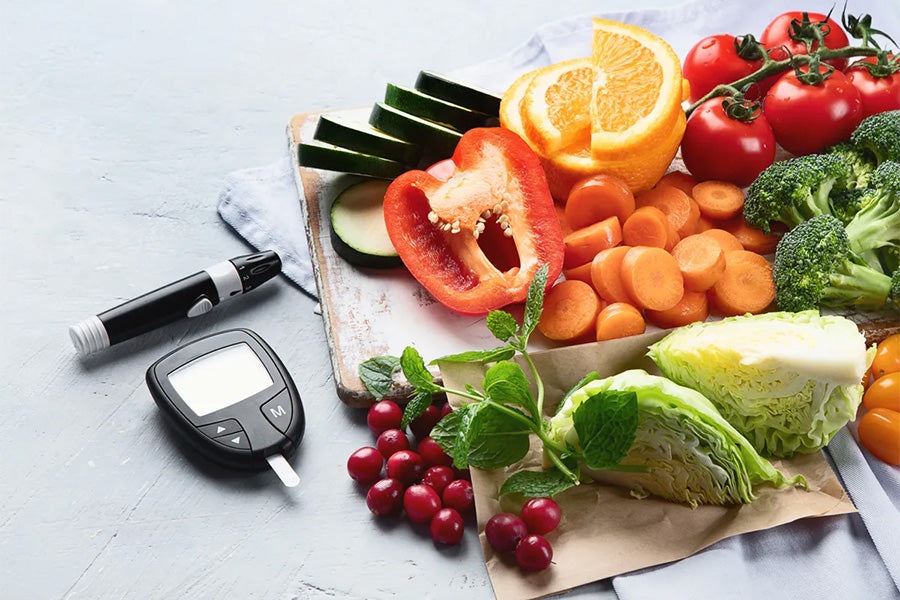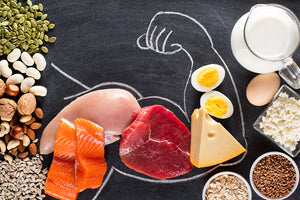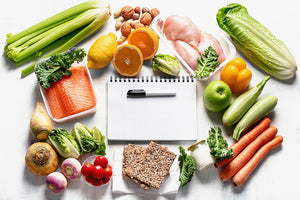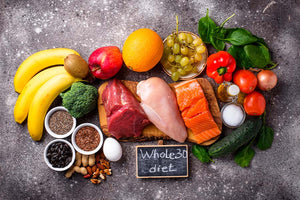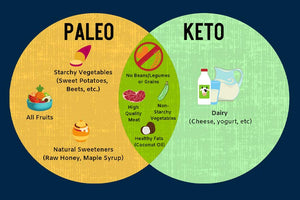Diabetes is a medical condition which can be effectively managed by careful and mindful meal planning. Food has a significant role in determining the health and well-being of a person with diabetes.
This is because foods high in simple carbohydrates and sugars can cause blood sugar levels to spike, while those that are low in carbs and contain healthy fats, protein, and fiber can help keep blood glucose levels under control.
Most of the meals you consume are broken down into sugar, also known as glucose and sent into your blood circulation. When blood sugar levels rise, your pancreas releases insulin, which acts like a key to allow sugar entry into your cells for energy usage.
If you have diabetes, your body either isn't producing enough insulin or cannot utilize the insulin it creates as effectively as it should. Too much blood sugar remains in your blood when insulin isn't enough or when cells stop responding to it. Over time, this can lead to critical health issues such as heart disease, blindness, and kidney disease.
There is no immediate cure available for diabetes, but lifestyle modifications, meal planning, increasing physical activity, and carefully selecting carbs can play a significant role in treating diabetes. In the last 20 years, the incidence of diabetes has increased due to the high prevalence of obesity, as per a report by the Centers for Disease Control and Prevention.
How to Monitor Blood Sugar Level?

Keeping track of your blood sugar level is an essential part of managing diabetes, and there are several things you can do to monitor and control it effectively. Some key strategies include counting carbs, including enough protein and healthy fats in your diet, and avoiding simple carbs and excess sugar.
It is vital to have a well-balanced diabetic meal plan that includes plenty of fruits and vegetables, lean protein sources, whole grains, and healthy fats. Whether you are new to managing diabetes or living with it for years, it is crucial to work closely with your healthcare provider. Your healthcare provider can help develop a personalized meal plan that will help keep your blood sugar levels stable throughout the day.
There are several ways to monitor your blood sugar level, including using a home blood glucose meter, wearing a continuous glucose monitoring (CGM) device, or undergoing regular blood tests at your doctor's office. One of the most accessible and most convenient methods for monitoring your blood sugar is using a home blood glucose meter. These devices are easy to use and can give you quick results within minutes of testing.
Make sure that your blood sugar level is always within your target range to keep yourself healthy and avoid complications. Monitoring your blood sugar level regularly is a simple but essential step towards achieving this goal.
If you find that your blood sugar levels are consistently too high or too low, there are several things that you can do to keep them within a healthy range. Some simple lifestyle changes, such as eating a healthier diet, exercising regularly, and monitoring your stress levels, can help regulate your blood sugar levels and improve overall health.
Related Article: 12 Habits You Should Break When Trying To Manage Your Blood Sugar
Meal Planning Tips

Diet has a crucial role in diabetes management, and meal planning is an integral part of this. Certain tips can help you ensure that your diabetes management plan is as effective as possible. Some of these include:
- Prioritize Healthy Foods
Focusing on a diet rich in fruits, vegetables, whole grains, and lean protein is vital for managing blood sugar levels effectively. This means minimizing processed foods and refined carbs with a high glycemic index and choosing options like fresh produce, nuts, beans, and legumes.
- Plan and Be Organized
One of the biggest challenges with diabetes management is often simply staying on top of things – it's easy to let things slip when life gets busy. To avoid this, plan as much as possible and keep things organized. Meal prepping or batch cooking can be helpful in this regard, as it can make it easier to stick to your diet when you have healthy food options readily available.
- Be Mindful of Portion Sizes
Another essential aspect of managing diabetes is knowing portion sizes and not overeating. This means paying attention to how much food you're eating and the type of food – choosing nutrient-dense options will help you feel fuller while keeping blood sugar levels in check.
- Make a Grocery List
Planning out your meals for the week will help you make sure you have all the ingredients you need on hand. Having a grocery list will also save you time and money at the supermarket.
- Be Flexible
Don't be afraid to mix things up and try out new recipes. This will help keep your meals exciting and prevent you from getting bored or demotivated. But be mindful of going for healthier options and not fall into the trap of mindless snacking.
- Maintain a Healthy Weight
If a person with diabetes is overweight, they may need to lose weight to improve their health. Losing even a small amount of weight can help manage diabetes and improve a person's overall health.
Regular physical activity is essential as exercise can help a person with diabetes lose weight, lower blood sugar levels, and improve insulin sensitivity.
Related Article: Quick Weight Loss Tips You Should Try
Remember that meal planning is just one piece of the puzzle for managing diabetes successfully – staying active, maintaining a healthy weight, and getting regular medical care are also essential factors. However, with the right tools and strategies in place, you can take control of your health and manage your diabetes effectively.
- Counting Carbs

If you have diabetes, you know that managing your blood sugar levels is essential. But did you know that counting carbs can help you control your blood sugar? Carbohydrates are one of the three macronutrients (along with fat and protein), and they're found in a wide variety of foods — from fruits and vegetables to bread and grains to milk and yogurt.
When you eat foods that contain carbs, your body breaks them down into glucose or blood sugar. And when your blood sugar goes up, so does your risk for diabetes complications.
That's why it's important to count carbs if you have diabetes. Knowing how many carbs are in the foods you eat can better control your blood sugar levels and reduce the risk of diabetes complications. Some simple tools you can use to help with carb counting include food labels, carb tracking apps, and glycemic index charts.
If you're ready to start counting carbs, talk to your doctor or a dietitian about the best strategies. And remember that making healthy choices — including eating plenty of fruits, vegetables, whole grains, and lean protein — can go a long way toward managing your diabetes and preventing complications.
Related Article: Carb Cycling for Weight Loss - A Step by Step Guide.
- Eat Enough Protein

Protein plays an essential role in diabetes management, as it is necessary for proper hormone function and blood sugar regulation. When managing diabetes, it is essential to eat enough protein each day to support healthy blood sugar levels and maintain overall body health. Good protein sources include lean meats, fish, eggs, nuts, seeds, and dairy products.
Eating a balanced diet that includes eggs, poultry and lentils can also help ensure getting enough protein each day. One strategy for ensuring that you get enough protein in your diet is to plan when grocery shopping or preparing meals at home.
This might involve stocking up on high-protein foods such as chicken or salmon fillets or including more beans or lentils in your meals. Focusing on protein-rich snacks such as Greek yogurt or nuts can help you get the protein you need throughout the day. With consistent effort and proper nutrition, it is possible to effectively manage diabetes and enjoy good health benefits.
- Include Healthy Fats

Including healthy fats in diabetes management is essential for maintaining overall health and wellness. These fats, which are found in nuts, avocados, olive oil, and fatty fish like salmon, can help regulate blood sugar levels and reduce the risk of developing other chronic conditions associated with diabetes.
Incorporating these healthy fats into your diet can promote heart health by lowering cholesterol levels and improving circulation. There are several different strategies that you can use to include healthy fats in your diabetes management routine. For starters, try swapping out some of the high-carbohydrate foods in your diet for healthier fat-containing options.
This could mean opting for nut butter instead of bread or grains for a snack or replacing some of your cooking oils with more heart-healthy options like coconut or olive oil.
Getting enough omega-3 fatty acids through foods like salmon, sardines, flaxseeds, soybeans, and walnuts can help ensure that you get the nutrients you need for overall health.
Recommended Food Choices for Diabetes Management
Diabetes is a severe condition that affects millions of people around the world. If you have diabetes, it is essential to make healthy food choices to manage your symptoms and prevent further complications. Some recommended food choices for diabetes management include fruits, vegetables, lean proteins like chicken or fish, whole grains, and low-fat dairy products.
One of the most important things to remember when managing your diabetes through diet is to focus on eating a variety of nutrient-rich foods. This means including plenty of fruits and vegetables in your diet and other unprocessed foods like whole grains and lean proteins.
Good fruit choices for people with diabetes include berries, citrus fruits, apples, pears, and melons. Vegetables high in fiber, like leafy greens and cruciferous vegetables like broccoli and cauliflower, can also help manage diabetes.
In addition to fruits and vegetables, other foods that can help with diabetes management include lean proteins like chicken or fish and healthy fats like avocados or olive oil. Dairy products like low-fat yogurt and cottage cheese are also good choices if they are not heavily processed or loaded with sugar.
Some high-fiber complex carbohydrates, like oatmeal, quinoa and starchy vegetables, winter squash, corn, and peas, are good choices for people with diabetes, as they can help keep blood sugar levels stable.
Healthy fats like avocados, flaxseeds, nuts, peanuts, and olive oil are recommended choices for diabetes. Overall, the key is to choose whole, unprocessed foods whenever possible.
Some Food to Avoid
While everyone's dietary needs are different, these are some general guidelines to follow if you have diabetes. Certain foods that people with diabetes should avoid can contribute to spikes in blood sugar levels. These include sugary drinks, processed carbs, and unhealthy fats.
Sugary drinks like soda, juice and sports drinks, processed carbs like white bread, pasta, and rice can also cause blood sugar levels to rise. Unhealthy fats like trans fats and saturated fats can also wreak blood sugar levels.
Sugary juices, flavoured drinks, sweet cereals, simple carbs, and packaged foods are other foods you should try to avoid to manage diabetes. So if you have diabetes, it's essential to limit your intake of these foods and drinks.
TRENDING ARTICLES
7-Day Meal Plan for Diabetic Patients
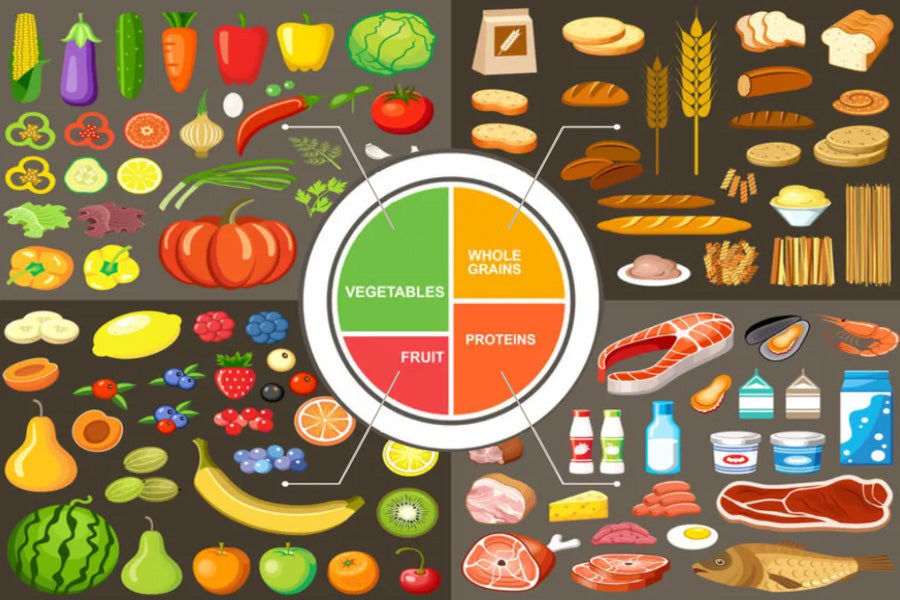
Day 1
Breakfast: 4 Egg Muffins (352 calories & 8 g carbs)
Snack: 5.2 oz (148 g) Greek yogurt (0%) + 1 oz. (28 g) almonds (248 calories & 12 g carbs)
Lunch: 1 serving Salad Niçoise (405 calories & 18 g carbs)
Snack: 3 oz. (85 g) shelled edamame (120 calories & 8 g carbs)
Dinner: 1.5 serving Quiche (401 calories & 10 g carbs)
Total: 1506 calories & 56 g carbs
Day 2
Breakfast : 4 Egg Muffins (352 calories & 8 g carbs)
Snack : 4 oz. (114 g) apple + 1 tsp. nut butter (155 calories & 20 g carbs)
Lunch: 1.5 serving Quiche (401 calories & 10 g carbs)
Snack: 2 servings of Cottage Cheese Parfait with Berries (250 calories & 25 g carbs)
Dinner: 1 serving Rosemary Chicken (Tuscan Style) + 1 serving Cauliflower Mash (375 calories & 14 g carbs)
Total: 1533 calories & 77 g carbs
Day 3
Breakfast: 1.5 serving Cauliflower Oatmeal + 2 eggs (353 calories & 25 g carbs)
Snack: 4 oz. (114 gram) hummus (200 calories & 17 g carbs) Tip: Enjoy with some of the daily veggies
Lunch: 1 serving Peruvian Chicken Wrap (375 calories & 16 g carbs)
Snack : 5 oz. (143 gram) Shelled Edamame (200 calories & 14 g carbs)
Dinner: 1.5 serving Mustard Baked Chicken Tenders + 3 oz. (86 g) cooked quinoa (382 calories & 21 g carbs)
Total: 1510 calories & 93 g carbs
Day 4
Breakfast: 1 serving Chia Seed Pudding (201 calories & 23 g carbs)
Snack: 4 oz. (114 gram) apple + 1 tsp. nut butter (155 calories & 20 g carbs)
Lunch: 1 serving Peruvian Chicken Wrap (375 calories & 16 g carbs)
Snack: 2 Sugar-free Chocolate Chip Cookie (330 calories & 19 g carbs)
Dinner: 1 serving Salmon with Lemon Butter + 3 oz. (86 g) cooked quinoa (439 calories & 17 g carbs)
Total: 1500 calories & 95 g carbs
Day 5
Breakfast: 1 serving Chia Seed Pudding + 2 eggs (345 calories & 24 g carbs)
Snack: 5.2 oz (148 g) Greek yogurt (0%) + 1 oz. (29 g) almonds (248 calories & 12 g carbs)
Lunch: 1 serving of Salmon with Lemon Butter (400 calories & 14 g carbs)
Snack: 1 Sugar-free Chocolate Chip Cookie (165 calories & 9 g carbs)
Dinner: 1.5 servings of Turkey Chili (348 calories & 25 g carbs)
Total: 1506 calories & 81 g carbs
Day 6
Breakfast: 1 serving Protein Pancakes + 2 tsp. nut butter (372 calories & 24 g carbs)
Snack: 1 serving Keto Peanut Butter Fat Bombs (247 calories & 3 g carbs)
Lunch: 1.5 serving Turkey Chili (348 calories & 25 g carbs)
Snack: 1 Sugar-free Chocolate Chip Cookie (165 calories & 9 g carbs)
Dinner: 1.5 servings of Zucchini Lasagna (366 calories & 18 g carbs)
Total: 1498 calories & 79 g carbs
Day 7
Breakfast: 1 serving Cottage Cheese Pancakes + 1 tsp. nut butter (300 calories & 23 g carbs)
Snack: 5 oz. (143 gram) Shelled edamame (200 calories & 14 g carbs)
Lunch: 1.5 servings of Zucchini Lasagna (366 calories & 18 g carbs)
Snack: 1 serving Keto Peanut Butter Fat Bombs (247 calories & 3 g carbs)
Dinner: 1.5 serving Tofu Scramble (Vegan) (357 calories & 25 g carbs)
Total: 1470 calories & 83 g carbs
Conclusion
Diabetes meal planning can seem daunting at first, but with a few simple tips, you can be on your way to creating healthy and delicious meals. Start by considering the role of food in diabetes management and how different foods affect blood sugar levels. Next, focus on portion size and choosing healthy weight-loss strategies that fit into your lifestyle.
Managing diabetes is a lifelong commitment that can seem overwhelming at times, but you can maintain healthy blood sugar levels by following these simple tips.
Reading List
Omega 3 Vs Omega-3-6-9: What Do the Experts Say?
7 Day Vegan Challenge - A Balanced Whole Food Plant-Based Diet
Article Sources
- “What Is Diabetes? | NIDDK.” National Institute of Diabetes and Digestive and Kidney Diseases, https://www.niddk.nih.gov/health-information/diabetes/overview/what-is-diabetes.
- Boston, 677 Huntington Avenue and Ma 02115 +1495‑1000. “Carbohydrates and Blood Sugar.” The Nutrition Source, 5 Aug. 2013, https://www.hsph.harvard.edu/nutritionsource/carbohydrates/carbohydrates-and-blood-sugar/.
- Wakhloo, A. K., et al. “[Effect of dietary fat on blood sugar levels and insulin consumption after intake of various carbohydrate carriers in type I diabetics on the artificial pancreas].” Deutsche Medizinische Wochenschrift (1946), vol. 109, no. 42, Oct. 1984, pp. 1589–94. PubMed, https://doi.org/10.1055/s-2008-1069418.
- Gannon, Mary C., et al. “An Increase in Dietary Protein Improves the Blood Glucose Response in Persons with Type 2 Diabetes.” The American Journal of Clinical Nutrition, vol. 78, no. 4, Oct. 2003, pp. 734–41. PubMed, https://doi.org/10.1093/ajcn/78.4.734.
- Diabetic Retinopathy | National Eye Institute. https://www.nei.nih.gov/learn-about-eye-health/eye-conditions-and-diseases/diabetic-retinopathy.
- Diabetes Quick Facts | Basics | Diabetes | CDC. 2 Mar. 2022, https://www.cdc.gov/diabetes/basics/quick-facts.html.
- “Continuous Glucose Monitoring | NIDDK.” National Institute of Diabetes and Digestive and Kidney Diseases, https://www.niddk.nih.gov/health-information/diabetes/overview/managing-diabetes/continuous-glucose-monitoring.
- Beasley, J. M., & Wylie-Rosett, J. (2013). The role of dietary proteins among persons with diabetes. Current atherosclerosis reports, 15(9), 348. https://doi.org/10.1007/s11883-013-0348-2.


